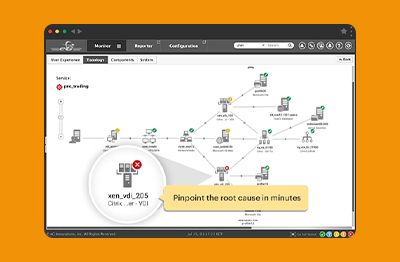XenServer
What is XenServer?
XenServer is an open-source server virtualization platform based upon the open-source Xen hypervisor (a type-1 / bare-metal hypervisor). XenServer is used for hosting virtualized server and client operating systems and provides performance comparable to that of bare metal servers.
The key features of XenServer are:
- Consolidating multiple virtual machines (VMs) onto a physical server
- Reducing the number of separate disk images to be managed
- Allowing for easy integration with existing networking and storage infrastructures
- Enabling you to schedule zero downtime maintenance by live migrating VMs between XenServer hosts
- Assuring availability of VMs by using high availability to configure policies that restart VMs on another server in case one fails
- Increasing portability of VM images, as one VM image works on a range of deployment infrastructures
XenServer is developed by Citrix, who open-source the basic product. Citrix also offer a paid-for commercial version with enterprise support and a fuller range of features and management tools.
At various points in its history the commercial Citrix version of XenServer has been known as the “Citrix Hypervisor”.
What is a XenServer pool?
A XenServer pool is a collection of standalone hosts that operate as a single resource: sharing identical hardware, identical setup, and the same shared resources. VMs deployed on one host can be readily migrated to another member host, and the pool master serves as the single point of management.
What is XenCenter and what alerts does it report?
XenCenter is a Windows-based client software that enables users to install and manage XenServer environments. Using the XenCenter management console, you can install, provision and run virtual machines on a XenServer host.
The XenCenter Alerts view displays:
- Performance alerts - Performance alerts can be generated when CPU, memory usage, network, storage throughput, or VM disk activity exceeds a specified threshold on a server or VM.
- HA (High Availability) status alerts - Alerts can be generated for changes to a pool’s high availability status.
- End of life alerts - Alerts are generated when the XenServer versions on your managed servers are approaching or reach their end of life.
- Certificate alerts - Alerts are generated when the certificate on a XenServer hypervisor is approaching its expiry date or has expired.
What is Xen Orchestra?
Xen Orchestra (XO) is an open-source web-based management platform for XenServer and the Xen hypervisor. It provides a comprehensive set of tools and features that simplify the management, monitoring, and automation of XenServer environments. Xen Orchestra is designed to enhance the administration and usability of XenServer, making it easier for users to manage their virtualized infrastructure.
Xen Orchestra is developed by a French third-party vendor Vates who offer a commercial, fully supported version which offers an alternative to Citrix’s commercial XenServer offering.
Why is XenServer monitoring challenging?
As with any virtualization technology, any failure of a XenServer hypervisor affects all the VMs running on it and the applications hosted on the VMs. Hence, monitoring of the XenServer hypervisor to ensure that it is working well is important. They types of issues that can affect a XenServer hypervisor include:
What is Dom0 in XenServer and Xen?
One of the key concepts of Xen is domains. “Domain 0” (Dom0) is the software portion that starts together with the server, an operating system with direct access to the underlying hardware that provides services to hosted machines and an admin management interface. In practice, Dom0 is a “specialized” Linux version that doesn’t just acts as a hypervisor, but also remains accessible for all management operations. Hosted VMs are active within a DomU (that U stands for Unprivileged) and must make requests via Dom0 for access to hardware resources, whereby Dom0 will translate or emulate such requests as appropriate.
Because Dom0 essentially runs a Linux OS, many applications designed for Linux can be run in dom0, an application added to the hypervisor in Dom0 is known as a kernel module. Commercially supported versions of XenServer supplied by Citrix do not support users adding applications to dom0 and strongly discourage the practice which is inherently less secure and can compromise hypervisor performance. So, whilst it is possible to add monitoring tools such as Nagios into Dom0, Citrix recommend the use of tools that consume XenServer metrics via supported interfaces validated via their Citrix Ready program. eG Enterprise is a Citrix Ready validated solution that does not compromise the integrity of Dom0.
How does eG Enterprise complement XenCenter for monitoring XenServers?
eG Enterprise provides 360 degree monitoring of XenServers hosts and pools.
- Monitor all aspects of hypervisor performance including CPU utilization, memory utilization, disk IOPS.
- Monitor VMs from the outside and from the inside.
- Track the percentage of physical server resources that each VM is taking up.
- Look inside each VM and identify why a VM is taking up resources: is it a specific application, is it due to an increase in workload, etc.
- Use agents inside the VMs to get in-depth application-level insights and correlate application performance with VM performance and XenServer performance.
Unlike XenCenter which only provides real-time performance insights, eG Enterprise includes a host of dashboards and reports that IT admins need. Furthermore, with integration to ITSM systems like ServiceNow, eG Enterprise automatically opens tickets in the ITSM tool whenever a problem is detected and auto-closes the ticket whenever a problem is resolved.
XenCenter and XenServer leverage RRDs (Round Robin Databases) to store performance metrics, to save and limit storage the RRDs are regularly consolidated, and older data becomes increasingly less granular. Many organizations with helpdesk operations and / or compliance auditing needs therefore choose a third-party monitoring tool to overcome the auditing and visibility limitations of the native RRDs.
To learn more about eG Enterprise monitoring for Citrix XenServer, please see: https://www.eginnovations.com/supported-technologies/citrix-monitoring/hypervisor-performance-management


